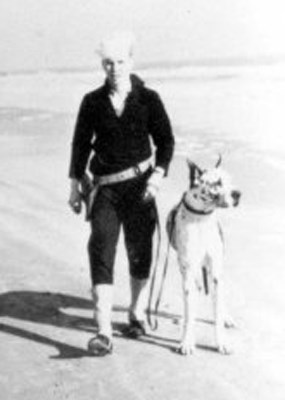
Padre Island National Seashore archives Pilot training began at the new Naval Air Station in Corpus Christi in March, 1941 and the beginning of World War II accelerated it. By the end of 1942 Corpus Christi NAS and its auxiliary bases were processing 2,500 pilots per month and became the largest naval pilot training facility in the world. Among the notables trained there were future President George Bush, Senator/Astronaut John Glenn, actor Tyrone Power, and TV emcee Bob Barker. Among other training disciplines that were increasing was the need to practice bombing. Early in the war the island was declared off-limits to civilians, all information concerning activity on the island was declared classified and seven bombing targets (large white bull's-eyes encircled by concentric white rings 100 yards in diameter) and eight strafing targets (vertical cloth or paper targets) were built spaced about five miles apart. Bombs dropped on the targets were usually very small and contained only enough explosive for pilots to check their accuracy. The principal practice bomb, the Mark IV, was only nine inches long and contained a 40-gauge shotgun shell in the nose as an explosive. Some larger bombs were dropped on occasion, however (for example 500-pounders), and typically half of their weight would be explosive. With the construction of the targets also came the need to service and repair them and naval personnel had to perform this duty. Initially, crews had to travel by boat to reach many of the targets, but eventually a housing facility known as Caffey barracks was built. Caffey barracks is still on the island and now serves as the ranger station. Aerial bombing was not the only military activity on the island during the war. By 1942 German submarines had established a presence in the Gulf of Mexico and there was concern that they would be used to infiltrate spies or saboteurs into the country, as was common in that day. The Gulf coast, with its numerous oil fields and shipyards, offered many potential targets for all three. Consequently the U.S. Coast Guard started patrolling Padre Island, along with the rest of the U.S. coastline, with men, horses, and dogs. By 1943, nine patrol stations were established on Padre Island. There is no indication that spies or saboteurs ever landed on the island, but there was plenty of evidence of U-boat activity against shipping in the debris which washed up on the shore. Between 1942-43 33 Allied ships were sunk and 434 lives were lost. As the war progressed U-boat losses grew and bombing of U-boat support and production facilities in Europe increased. As a result the submarine threat in the Gulf of Mexico ended by 1944 and Coast Guard patrols stopped. Navy training and bombing continued though, through the end of the war. In spite of the new military presence on the island, cattle operations continued as they had for over a hundred years. Bombing practice was halted during the annual round-ups and for the rest of the year several thousand cattle roamed the island as they had since the days of Padre Balli. Observers noted that "the cattle move in and around the targets as soon as the firing stops and graze bombing areas when the ranges are quiet. At the first sound of an airplane, they move out of the area without any prompting". Post-WarUse of Padre Island as a bombing range continued through the Korean Conflict and into the 1960's. The range was decommissioned in 1966 and the Navy sent out ordinance experts to sanitize the ranges of all unexploded ordinance. The sand at the targets was sifted down to a level of 18 inches using heavy equipment and the bombs removed. Unfortunately, long after the ranges were closed unexploded ordinance was still being found on occasion and some souvenir hunters were injured by improperly handling munitions, whose explosive charges had become increasingly unstable as time had passed. Unexploded ordinance still turns up, albeit very infrequently. If a metal object is seen sticking from the ground, do not touch it, mark its location and report it immediately to a Park Ranger. |
Last updated: September 8, 2016
